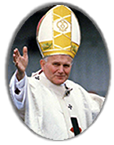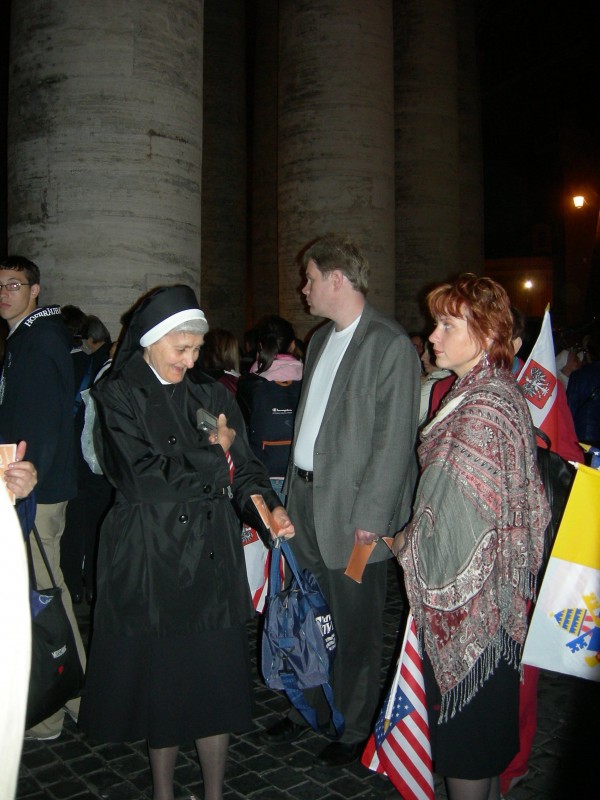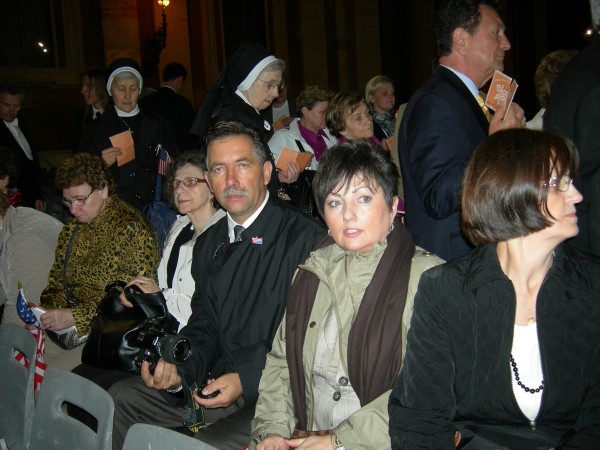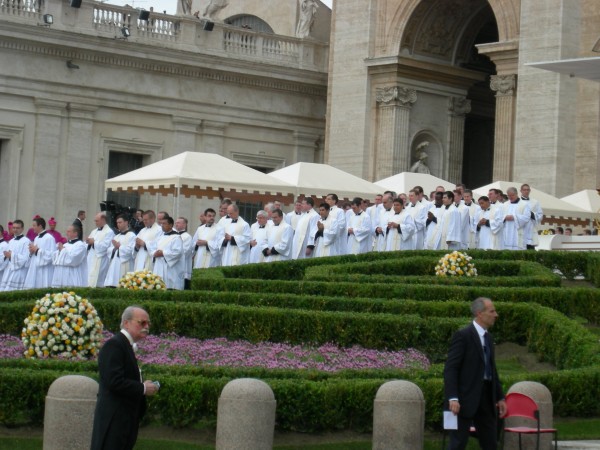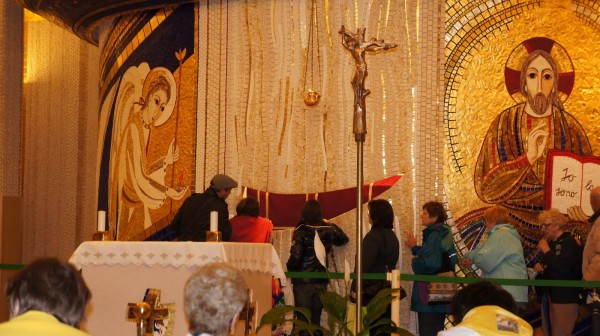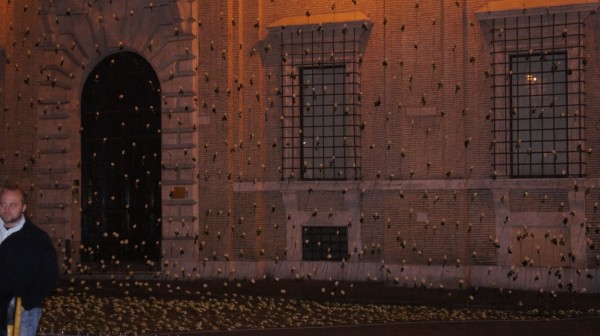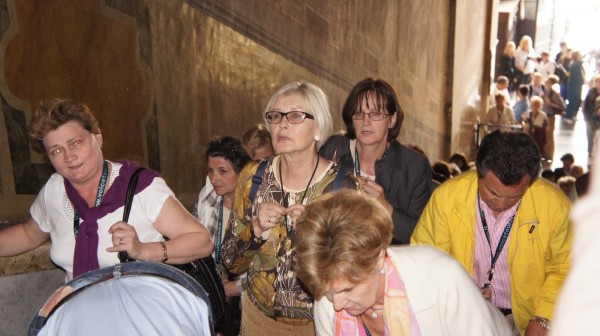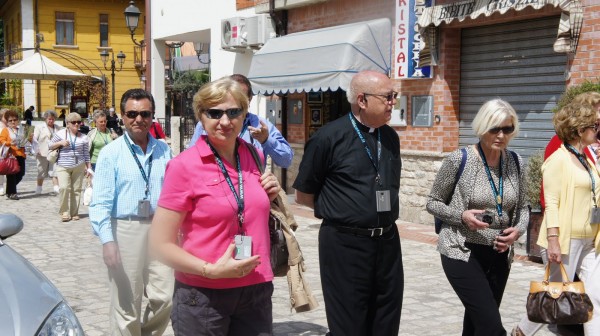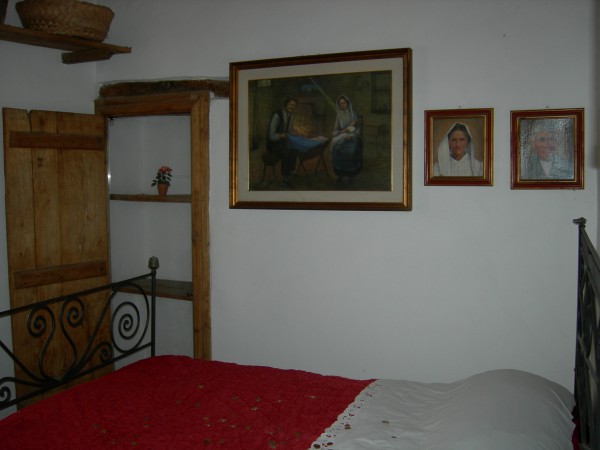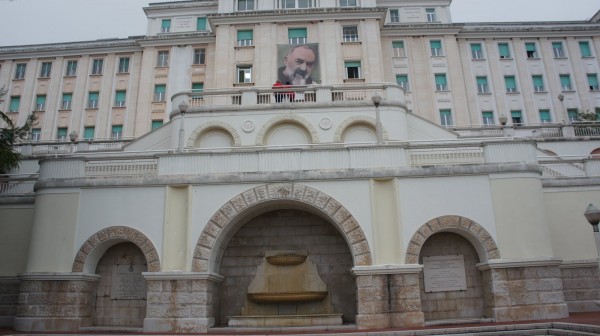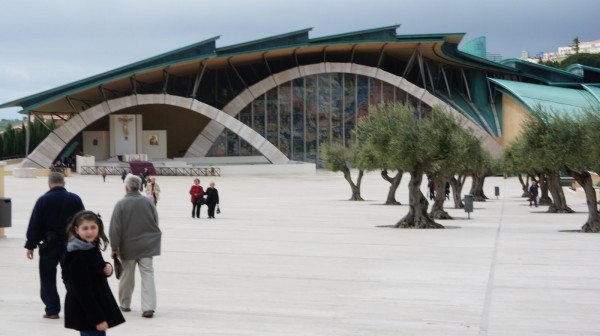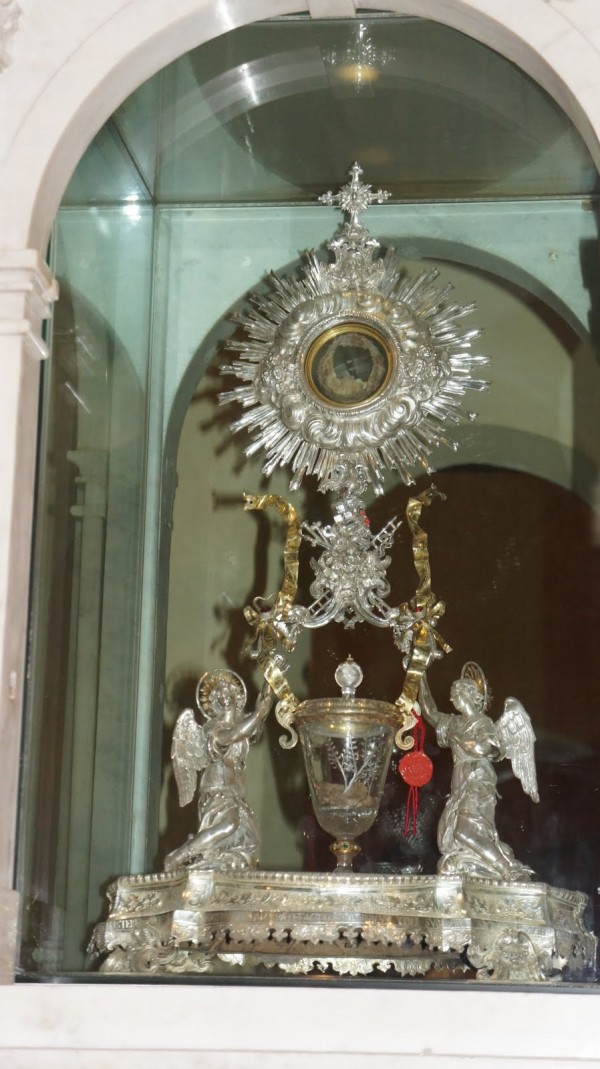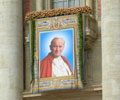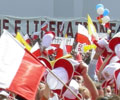Pilgrimage to the Beatification of Pope John Paul II – May 1, 2011.
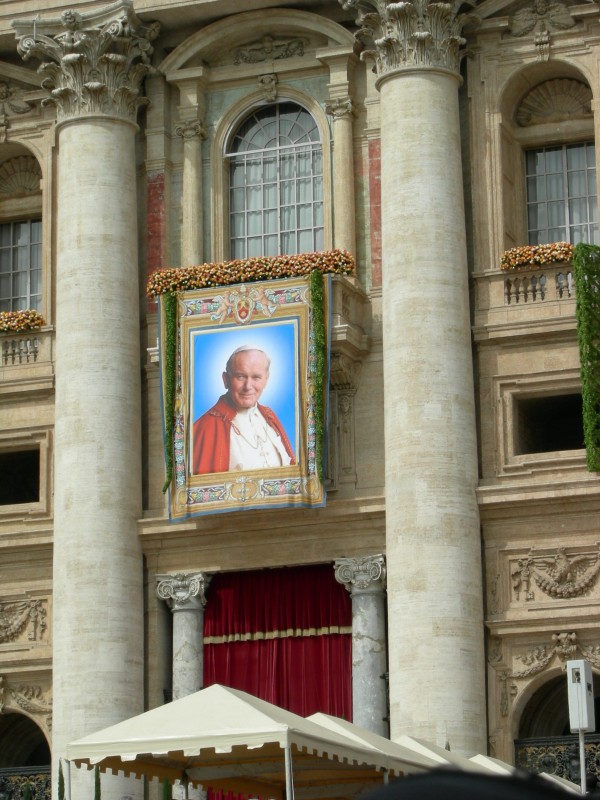
I would like to begin by saying that Mr. Michael Pajak, who was our pilgrimage leader to Rome for the Beatification of Pope John Paul II, was friendly, professional, accommodating, and a perfect gentleman in his leadership of our group of forty-three pilglrims to Rome.
We left JFK shortly after 9:00 PM on Friday, April 29. We sat in the extreme back of the airplane, seat numbers in the 40’s. Who says they don’t feed you on the airplane anymore? On our way to Zurich, Switzerland, we were first given a packet of “happy variety crackers, which were very tasty. About an hour and a half later, we had dinner, composed of cheese ravioli, salad, bun and butter, triple-chocolate brownie, and any beverage of water, tea, coffee, soda, or juice. Before landing in Zurich, we were treated to a breakfast of croissant, butter, jelly, a chunk of Monterey Jack cheese, tea or coffee.
During our stop in Zurich the next morning, about 11:00 AM Zurich time, we met a young man from Canada, about 21 years of age, who received his Master’s degree at the Catholic University of America in Washington and was now pursuing his Doctorate in “Sacred Music.” He told of a story of a glacier in Canada that to many resembled the Virgin Mary. A poet, moved by the glacier and story, wrote a poem about it, and the poem was later set to music. During his research on his thesis for his Doctorate, our Canadian young man found the music, which moved and awed him deeply. The music was never published.
On our way to board the plane to Rome two tall, lanky teenage girls approached us and asked where we were from. When we mentioned NYC in the USA they said, “Wow, NYC in the USA.” When we added that we live and work in Brooklyn, they said, “Wow, it gets better by the minute. What a hell of a time you’re going to have.”
The flight from Zurich to Rome was about 2 and ½ hours. We were served lunch of a ham and pickle sandwich, the bread being more of an elongated French bun, absolutely delicious. When we alighted from the plane, on our way to pick up our luggage, a young woman asked to take a picture of Sr. Colette and me. She was from the Ukraine and had been educated in a Ukrainian Catholic school. I suppose we reminded her of her school days as a child.
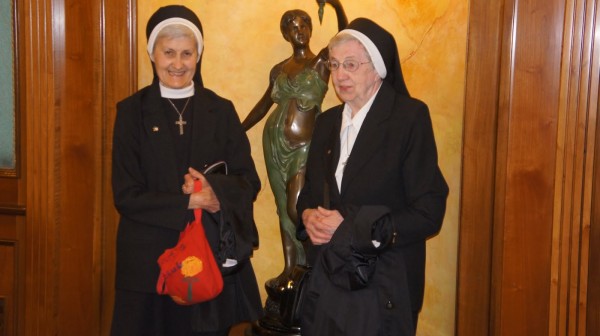
We arrived at the Capital Hotel Inn in Rome at approximately 3:30 PM, Rome time. We settled in, got refreshed and had dinner at 7:30 PM. in the hotel dining room. Shortly after, we scrambled into bed, to be ready to rise at 3 AM for the bus ride to St. Peter’s Square. (Our hotel room was spacious and the beds comfortable. The TV had two English channels, CNN and 7, with news reports. The doorknob to enter our room was in the center of the door, not on the left as we’re accustomed to in America. The plastic card that we had to scan to enter the room was also used to put the lights on. However, we did not know that, so we manually put on the lights. However, they went out three minutes later. We subsequently learned that when you leave your room you must leave all the light switches in the “on” position, so that when you push your plastic card into the slot, the lights will turn on. When you remove the card, the lights extinguish. The towels were something to be desired. They were linen, not terry cloth, so they did not absorb water very well.
May 1 – Beatification Day
The hotel telephone rang at 3 AM to getus up on the day of Beatification. At the hotel desk in the lobby we each picked up a breakfast bag of juice, fruit, sweet cracker bread and apricot jellies. We dressed warmly because it was cold and damp. We took our rain caps if the ain that was predicted materialized. It did not and the women who took umbrellas used them to shield themselves from the sun. We boarded the bus at 4 AM and parked far away from the Square because of the hundreds of thousands of people in Vatican City. We walked long to the Square, had to pass our carry-ons and purses through a scanner, and then, only because we had a special ticket, we were allowed entrance towards the front of the Square, in fact six rows from the front of the sanctuary on the far right. How was it possible for a simple group of pilgrims from America to be so privileged as to receive such great seats? Administrator of John Paul II Foundation – Fr. Krzysztof Wieliczko provided these special tickets for us. The seats in front of us were reserved for dignitaries from all over the world. The area that formed the sanctuary was bedecked with numerous flowers and to the right and left of the altar was something of an oasis, a beautiful tree at the base of which was a charming rock garden.
I must mention the three young people from Spain to my right, two young men and one young lady, who slept soundly until Mass began. But once Mass started, they were attentive and prayerful throughout. I must mention also the little group of people three rows behind us. Two families who each had three very young boys, all robed in little blue hoodies. When I discovered that they had all boys and no girls, one of the fathers said that he and his wife were waiting for a set of twin girls. I asked one of the fathers, “What are these little ones doing here? Will they persevere for such long hours?” He replied, “We brought them here so that maybe one of them would become a priest.” Isn’t that magnificent! It brought tears to my eyes. I must tell you that I wondered very seriously how these 3 and 4year olds would last these long hours of the Mass. Well, they ate, drew and colored pictures, read picture books and did what little boys do to entertain themselves. I wonder what happened when they had to go to the bathroom. Those portable potties are not a pretty sight amidst the grand columns of St. Peter’s Basilica. I discovered later that these two families were able to have such good seats because they knew someone in the Vatican.
It seemed as if all the priests in their white surplices, all the bishops and cardinals in their reds, in the whole world were present for the Beatification Mass. We thought Mass would never begin. But it did, because in came our own Pope Benedict XVI, visibly exulting in the fact that it was he who would beatify his dear friend, JPII. His sweet smile of peace and great joy was beautiful to behold.
It wasn’t long after Mass began, that the singing and praying stopped for a moment for an announcement made in various languages. We were politely asked to cease our cheering, our clapping of hands and banner and flag waving our of respect for the solemnity of the occasion and the reverence owed Christ our High Priest on the Altar of Sacrifice. And in obedience, the throng obeyed.
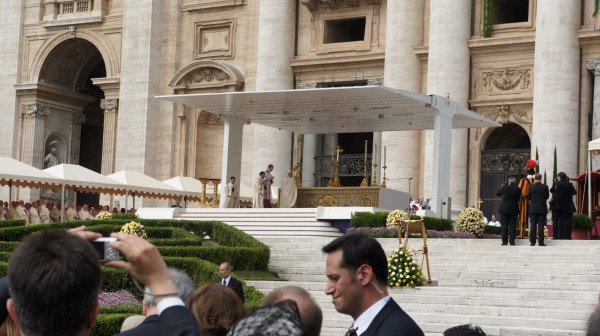
What we beheld and heard in St. Peter’s Square before and during the Mass was the Church triumphant, the glorious Church, the universal Church. On the very day that Evil Incarnate was killed, the light of Christ, the holiness of the Church, and the triumph of Life shone in all its splendor in the person of our beloved John Paul II. Just as Jesus is present to us at Mass and in our hearts in Holy Communion, so was He present in the person of JPII to every individual in that square and in Vatican City and in Rome, where the faithful gathered in the hundreds of thousands in the streets and environs of Rome. It was amazing and phenomenal and glorious and splendid and magnificent. The Christian world rejoiced and triumphed. Men, women and children of every nation were there to thank and praise God for the gift of Pope John Paul II to the world and to the Church.
Immediately following the Mass, groups filed into St. Peter’s Basilica to view the remains of JPII. was the one great frustration, disappointment, sorrow that I experienced throughout the entire ceremony. After the dignitaries entered, other groups were allowed in. It was finally our group’s turn. We rushed to the high altar near which the casket reposed and the closer we got, the more the crowds pushed and shoved. As hard as I tried to get a view of the casket, I could hardly spare a glance in fear that I would be knocked down. I had to work hard to keep on my feet, so much so that all I wanted to do was to get out. I had to go the way of the crowd; there was no other way out. I eventually reached the back of the basilica, close to the exit, where I found many of our group. This event was for me the one great disappointment of the entire pilgrimage.
You should have seen St. Peter’s Square now that the crowds were leaving; it was littered like
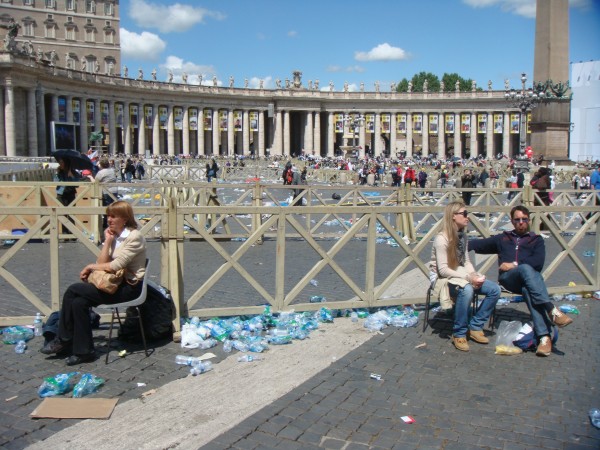
Times Square is on New Year’s Eve. Besides the litter, chairs were found helter-skelter all over. I wonder how long it took to clean up.
On the days following Beatification Day we toured Rome. We visited the Spanish steps, which are not Spanish at all, but steps leading upward to the Church of the Bl. Trinity, cared for by the Franciscans. The steps were crowded as always but no one visits Rome without climbing or sitting on those steps. When we arrived at the Fountain of Trevi, made famous by the old movie, “Three Coins in a Fountain,” it was even more crowded than the Spanish steps. People there were eating, reading, sharing friendship, lounging, taking pictures, and tossing in coins. Sr. Colette and I threw a euro coin into the fountain, standing with our backs to the fountain, using our right hand to fling the coin over our left shoulder. It had to be done that way in order to insure a return to the fountain. We met two young girls from California eating ice cream and genuinely enjoying their unique experience. As we continue our tour of Rome, we come across a building that houses the Radio Maria station. One of the outside walls of that building has no windows. Prior to the beatification of JPII, a net that covered the entire window-less wall was draped over it completely. On that netting people would place white roses in honor of JPII, and white roses only because he loved white roses, having tended the Vatican white rose garden himself. We also took pictures of the only coffee shop in all of Italy, made its coffee from beans imported from Brazil only. This coffee shop is visited by celebrities, secular and clerical, including of course our own JPII. By the way, it’s very expensive.
Next we visited the catacombs of St. Callixtus. We learned that the catacombs were not hiding places for persecuted Christians, but cemeteries, burial places for Christians. Many Christians were buried in public cemeteries above ground or on grounds of Christians who owned private property. Excavation of underground places to bury Christians began in the second century. In the Catacombs of St. Callixtus we observed the crypt of St. Cecilia, whose statue bears a cut in the neck where she was struck and the fingers of her hands demonstrate her belief in the Trinity. The extended index finger of her left hand symbolizes the one God and the three extended fingers of her right hand symbolize the three Persons. We learned why the fish symbol is the most famous ancient Christian symbol. Its letters FISH in Greek (FISH being Ichthus in Greek) mean Jesus/Christ/God’s Son/Savior.
This day we had Mass. Fr. Joe Szpilski, our pilgrimage’s spiritual guide, was the celebrant. I don’t recall whether it was in St. John Lateran or another cathedral that we entered a crypt in which was the “Holy of Holies,” meaning that the fresco of Christ was of mysterious origin because all the media used to paint the picture have no similarities or likenesses to what artists use today to paint. In other words, the painting is supernatural.
We climbed on our knees the Holy Stairs, the very stairs that our Savior climbed on the way of the cross. Men, women, children, young and old, praying on their knees. Faith personified.
We visited the Basilica of St. Paul outside the Walls where circular portraits of the 264 past and present popes grace the periphery of the walls near the ceiling in the center knave. In the recent past there was only one space left for one more pope. Superstition has it that when the last circle is filled in with a pope, that will be the end of the world and the papacy. So what construction designers did was create a new wall of empty circular spaces ready for 27 more popes. Long live the Church and the world, I say.
On Tuesday, May 3,we head to Petrelcina in southern Italy, the town made famous by St. Padre Pio, who was born there.
As you may know, Padre Pio was beatified and declared a saint by JPII. Our newly beatified pope also went to confession to Padre Pio and wrote to him on occasion. In a little museum attached to the church where Padre Pio celebrated Mass there is an entire wall of bookshelves holding the letters from and to Padre Pio, including of course JPII’s letters. We venerated the crucifix from which Padre Pio received the stigmata. St. Pio is the first priest in the history of the Church to have received the stigmata. We learned that just before his death, the stigmata disappeared. In Petrelcina, we climbed the 17 steep and spirally stone steps to Padre Pio’s home of birth. Simplicity and poverty marked the family’s living quarters.
We traveled by our tour bus to San Giovanni Rotondo, which grew from a town of 20 hotels when Pio was alive to over 200 now in 2011, because of the pilgrims, who come to venerate the great Padre Pio. In this mountainous city a hospital was built by Padre Pio that now admits over 1000 patients, who pay what they can. Someone who has no means to pay is given medical treatment free. The hospital is like a light in the hills, or like a nurse dressed in her immaculate white uniform or like an angel bringing physical and spiritual solace to the suffering.
Our Fr. Joe celebrated Mass for all of us in the very church and on the very altar that St. Pio said daily Mass. I believe it was at this altar that Fr. Joe was joined by a few other priests, quite young, who treated Fr. Joe as if he were a bishop or at least a monsignor. Fr. Joe let them think that.
In San Giovanni Rotondo there is a brand new church in Padre Pio’s honor that can accommodate 6000 worshippers. The landscaping around it is stunning. As you approach the church, on either side of the piazza are pools, each one slightly higher than the other, creating waterfalls as one connects to the other. The pools are interspersed with olive trees and flowers. Gorgeous! There is a Holy Year Door in this church, which was opened and sealed by JPII. In a crypt is the casket containing the remains of Padre Pio. When you walk behind the altar where the remains are venerated you can touch the red velvet canopy that drapes the casket. It was an awesome experience.
On the last day of our pilgrimage we traveled to Lanciano in southern Italy quite close to the sea. Lanciano is renowned for the preservation of the real flesh and the real blood of Jesus Christ. In the 8th century a monk of St. Basil, one day after the consecration, doubted the Real Presence of Jesus in the Eucharist. In response to his doubt, the consecrated Host was changed into real Flesh and the wine into live Blood, coagulated in 5 globules, or chunks, irregular and differing in shape and size. The Flesh and Blood have the same blood type: AB. The Flesh and Blood have been preserved for 12 centuries. We worshipped the Real Presence of Jesus in that church in Lanciano. Scientists and doctors and made this conclusion over and over again: science and medicine, when called upon to testify, have given and certain and thorough response as regards the authenticity of the Eucharistic Miracle of Lanciano.
We went to bed late on Wednesday, May 4, and rose early at 3 AM on May 5 to reach the airport in time for our flight to the good ‘ole USA. Sister Colette was approached by a former third grade student Richard Jegielski, who recognized Sister in the airport in Zurich on our return home. We couldn’t stop long to chit-chat but the young man was so delighted to have recognized Sister.
Sister Colette and I will be forever grateful to the Lord and will magnify His name forever for this great grace of witnessing the Beatification of our own beloved Pope John Paul II.
s. Dorothea Jurkowski
